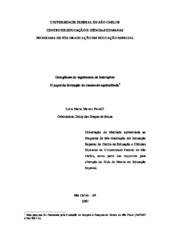Ontogênese do seguimento de instruções: o papel da formação de classes de equivalência
Abstract
Responding under the control of verbal commands is an important component of
human learning. The stimulus equivalence paradigm, as a model of symbolic behavior,
is useful in explaining how instructions specify contingencies of reinforcement: Words
can become members of equivalence classes with other stimuli (the referents) such as
objects, actions, relations, etc. This study investigated the formation of stimulus classes
among pseudo-words (verbs) and phrases (verbs and nouns). The specific goals were to
verify 1) whether the pseudo-words would become equivalent to actions and objects
(presented as recorded videotapes) and abstract pictures; 2) whether the words and
pictures would acquire instructional control over the non-verbal responding (performing
the actions, in isolation or directed to objects). Two experiments were conducted with
children aged four to six years. Experiment I used verb-like pseudo-words (Set A),
actions without a particular name established by the verbal community to which the
participants belonged (Set B) and colorful abstract pictures (Set C). In Experiment II the
auditory stimuli were pseudo-phrases (verb-object) and the videotaped actions were
directed to objects. Matching-to-sample procedures, with three comparison stimuli,
were used in both experiments to establish conditional discriminations among stimuli of
Sets A and B (AB relations) and among stimuli of Sets A and C (AC relations) and test
for class formation (BC and CB probe trials interspersed among baseline trials). In both
experiments, all children learned the baseline of conditional discriminations AB and AC
and demonstrated the formation of equivalence classes (BC and CB), relating, without
direct training, pseudo-words or phrases, actions and abstract pictures. Tests for
instructional control, conducted at the beginning of the study (pre-test), after children
learned the conditional discriminations (intermediate test) and after the formation of
classes (post-tests) demonstrated that the baseline was sufficient for establishing the control by spoken instructions, but not by the corresponding abstract pictures. After
class formation, all children followed both kinds of instructions . However, when tests
in Experiment II presented new phrases (recombinations of words from learned
phrases), no children showed recombinative generalization. This raises a question about
the necessary and sufficient conditions for establishing a generalized repertoire of
instruction following based on equivalence relations. The present results replicated and
extended the results of previous studies on equivalence relations as a mechanism by
which instruction following could emerge as a derived repertoire, without explicit
training
